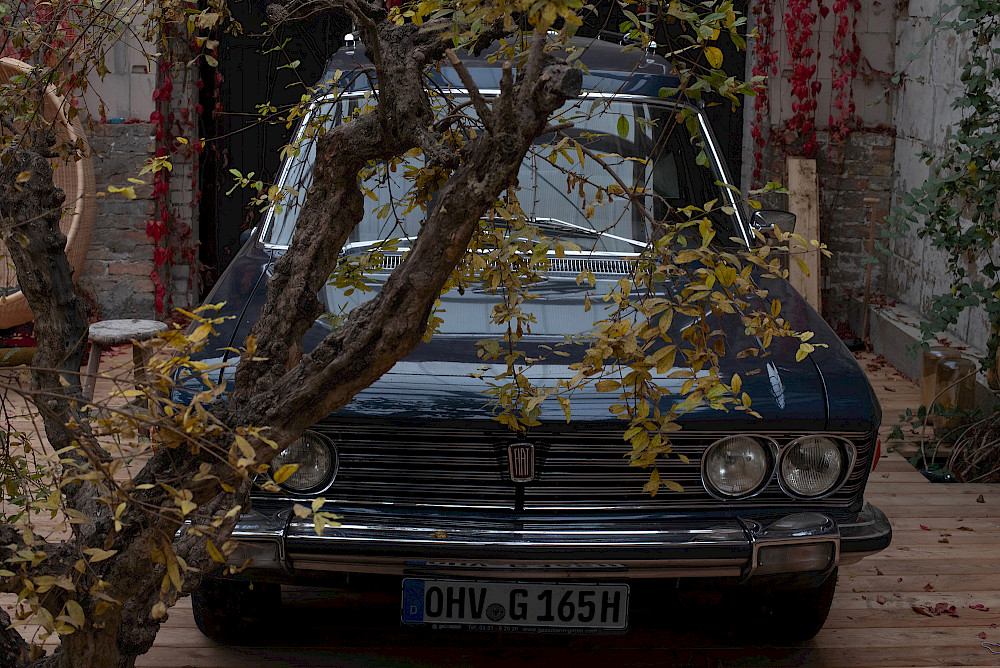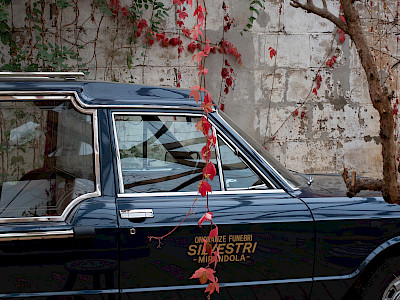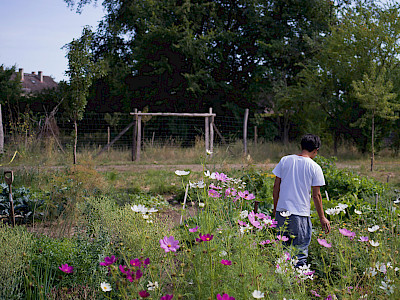14.05, 16 — 20.05, 23 — 26.05, 30.05 — 01.06.2024
Danh Vo Mexico City-Güldenhof
visual arts / mobile installation — premiere
Public space / Ieperlaan 20 Bd d'Ypres / KVS BOL / Monument voor de Oorlogsduif/au Pigeon-Soldat
Free
The projects of Danh Vo – born in Vietnam and raised in Denmark – weave personal intimacy into broader themes of history, power and memory. He takes objects steeped in historical and design contexts and realigns them in his installations and sculptures. Aestheticised in a new way, they amplify and transcend their pasts. When invited to participate in this year’s festival, Vo put forth a recently acquired 1970s Fiat hearse. He wished to repurpose the sleekly designed vehicle, with its large windows and spacious interior, as a mobile flower shop nomadically serving the people of Brussels. He collaborated with young car mechanics and electromechanics in training at a local school (Athénée Royal de la Rive Gauche, Laeken) to collectively design the transformation of the hearse. They worked together for months, taking art and floriculture courses, and composing bouquets using plant and mechanical components. Two worlds that seemed far apart now come together in this constant shift of meaning found at the centre of Vo’s artistic practice. The result is a new aesthetic venture, a visually iconic mobile sculpture circulating through the city. Vo’s work is a complex image of our society with multiple conflicting registers, a memento mori, a chariot spreading beauty in the urban sphere.
Practical details
The mobile installation can be seen at several locations, on the dates and times specified below (at the Monument voor de Oorlogsduif/au Pigeon-Soldat, in the square behind the KVS BOL or at Boulevard d'Ypres 20). Outside these hours, you can also see the vehicle parked at Boulevard d'Ypres 20 (through the glass door). The programme is subject to change in case of rain.
Excerpted from an article by Michaël Bellon — Bruzz Magazine, 8 May 2024
The object: a vintage FIAT hearse from the 1970s, which Vo had already owned for some time. This car, which naturally evokes associations with death, was to be given a new life. And in a very emphatic way, as Vo’s idea was to turn it into a mobile flower shop. Blanga-Gubbay: “Danh works a lot with assemblages, with putting together elements that come from different cultures or that seem formally or emotionally opposed, or even incompatible. The poetry that emerges from that contrast is very much present in his sculptures and installations. Here, the challenge and the thinking was to transform this unique car into a combination of motors and plants, of mechanical and organic elements, as well as to bring together two practices –auto mechanics and floral art– that are usually considered contrary, and very gendered.”
Blanga-Gubbay: “In Brussels there’s an entire tradition of training auto mechanics, and in the past we’ve collaborated with such schools. In September [2023], Danh and I went to the Athenée de la Rive Gauche to present the project to students aged between 16 and 18. We then assembled a group of 15 volunteers to help implement the project, and help devise it.
Vo: “I never knew how to approach that idea of a mobile flower shop, but sometimes you just have to wait for the right moment. The working method also ties-in a bit with Ikebana [the Japanese art of floral arrangement]. I have al- ways been fascinated by the way Sōfū Teshigahara [the Ike- bana grand master] worked. He used ceramic for his vases, but he used iron just as much. Really wild! When students at the school had to take apart and reassemble a car engine, I asked them which components would be good to use as a ‘vase’. These are obviously things I could never think up in my studio. Combining disciplines makes you think out-of-the-box in search of a common ground.” The students came up with ingenious systems to preserve and present the flowers inside the car. The experience also forced me to break free from entrenched terminology – ‘technical’, ‘crea- tive’, ‘craft’, ‘artist’... What do these terms all mean, and what kind of ideology, if any, is behind them?”
They also went on a school trip, travelling to Vo’s beautiful workshop in the Gutshof Güldenhof art centre [in Stechlin, Germany], to learn about flowers and floral art. Blanga-Gubbay: “For us, this was an open-ended project from the start. The process was more important than the result.”
- Michaël Bellon, May 2024
Testimonies from the participants
“What I really liked about the project was the teamwork and being surrounded by good people. I didn’t actually think the project would go that far. I was delighted to work with the ideas contributed by the artist and those around him. As for the car, I like the little tables we made for putting the flowers on – I find them very practical and so beautiful to look at. I think we can be proud of ourselves, especially for what lies ahead. I said to myself, ‘We were asked to do it and we did it.’ Truly, it was nice. I enjoyed it enormously. Why not work together again?”
- Lilian Ngono
“I liked transforming this old hearse, which is an ancient, almost dead vehicle, into something that’s alive, that we can use and even work with. The idea of a flower shop appeals to me. I took part in the project because I’m always keen to share experiences with other people, to work with people from other countries, people who are different from me. I’ve learnt a lot working on this car – plumbing, electricity... various things. It was great.”
- Assaad Cheikhi
“What I liked about this project was the idea of transforming an object that signifies death, and bringing it back to life. A car like this appears when someone has died, but if you see it being used as a flower shop, it’s shocking stuff, it’s bizarre. The things I liked were the work, the friends, the teachers who led the project, the artist, all of it.”
- Filipe Ribeiro
“What I very much liked about this project was the creativity around the car and the ideas that the artist came up with. I also liked the way we used wood to make the shapes and the interior. More generally, I liked that the school provided us with all the materials we needed for working. And having the support of the school and the artist.”
- Zacarias Benali Mimon
“I find the interior of the car so pretty, with the boxes. The outside is a bit less attractive, because of the metal structures. At first, I didn’t really believe in this project. Then, as time went on, I was impressed with the things being done to the car. And I greatly appreciated going on a trip to visit the artist.”
- David Botiz
“It was super well organised. Also the journey, because we were made welcome and we ate well.”
- Alassane Ndiaye
“I love Danh Vo’s art – what he’s done with the car is really nice... The link between a flower shop and the idea of death and thoughts of heaven. I really liked that. Also, the trip to Berlin was properly organised.”
- Mohamed Essaouiki
Presentation: Kunstenfestivaldesarts, Athénée Royal de la Rive Gauche
A project by Danh Vo in collaboration with students from Athénée Royal de la Rive Gauche, Laeken (ARRG): Marouan Arabate, Victor Cosman, Youssef El Azzaoui, Mohamed Essaouiki, Amin Fari, Enrique Martinez Vega, Felipe Ribeiro, Mouhamadou Seck, Youssef Bel Houari, Zacarias Benali Mimon, David Botiz, David Caldaras, Vladimir Chidovat, Alassane Ndiaye, Lilian Ngono, Mohamed-Amine Bounajma, Assaad Cheikhi, Anas El Aissaoui | Thanks to their teachers: Julien Daoud, Aldo Di Venti, Giuseppe Lavia
Commissioned and produced by Kunstenfestivaldesarts
Thanks to KBK Brussels
With the support of the Goethe-Institut Brussels




